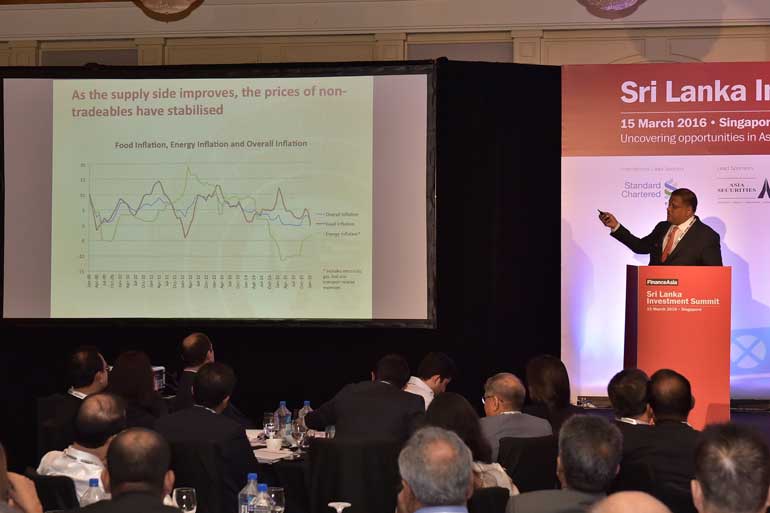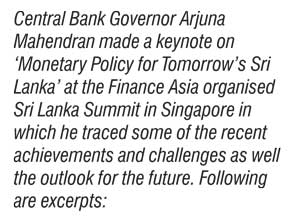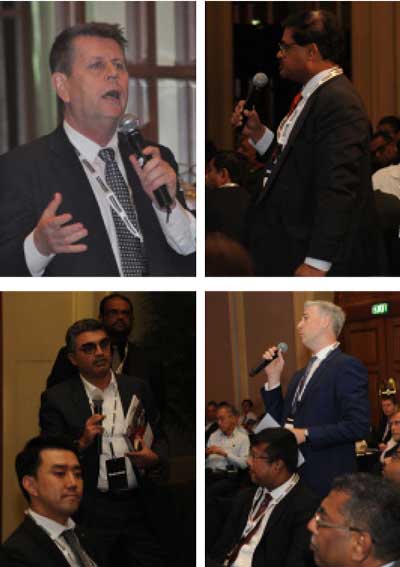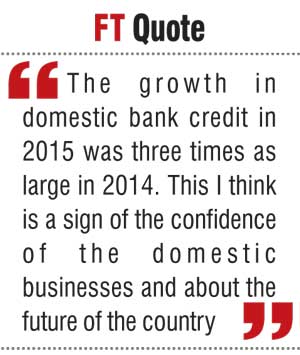Thursday Jan 09, 2025
Thursday Jan 09, 2025
Monday, 4 April 2016 00:00 - - {{hitsCtrl.values.hits}}

Central Bank Governor Arjuna Mahendran
My task is to outline how we are setting our monetary policy, cope with an economy that has very high expectations among the  local and foreign investment community but at the same time is hamstrung perhaps by some factors which are relic of the recent civil conflict in the country. The main constraint is the fairly large proportion of Government debt which was accumulated as a consequence of the war economy that dragged for over 30 years and more recently a big focus on Government outlays to fund infrastructure development to the country which perhaps now has to be reoriented as public private partnerships going forward. So debt has to be replaced by equity broadly in terms of the funding of the development process going forward and in the process we have to work out the monetary policy.
local and foreign investment community but at the same time is hamstrung perhaps by some factors which are relic of the recent civil conflict in the country. The main constraint is the fairly large proportion of Government debt which was accumulated as a consequence of the war economy that dragged for over 30 years and more recently a big focus on Government outlays to fund infrastructure development to the country which perhaps now has to be reoriented as public private partnerships going forward. So debt has to be replaced by equity broadly in terms of the funding of the development process going forward and in the process we have to work out the monetary policy.
In terms of our monetary policy as anyone expects from a Central Bank is to contain inflationary pressure. We have credit in the economy growing at over 25% Year on Year. Clearly that is a sign of exuberance but we don’t want that to get out of hand.
 The banking sector is very stable. We are planning to be in conformity of Basel III in the next couple of years by 2018. Our banking system is rather very sound. There has been an initiative to consolidate our banks because our banks are quite small. It has to be admitted but that process of consolidation is being reviewed as we speak. The principle concern of the current Government is that the process of consolidation was predicated perhaps too much on the fusion of Government capital into privately owned banks which we think is not the correct way to proceed.
The banking sector is very stable. We are planning to be in conformity of Basel III in the next couple of years by 2018. Our banking system is rather very sound. There has been an initiative to consolidate our banks because our banks are quite small. It has to be admitted but that process of consolidation is being reviewed as we speak. The principle concern of the current Government is that the process of consolidation was predicated perhaps too much on the fusion of Government capital into privately owned banks which we think is not the correct way to proceed.
We would rather have private capital drive the process of consolidation. So there’s course adjustment taking place. It’s not that we don’t believe in consolidation but the new Government would rather have it well sustained and embedded in terms of who participates in the process.
The trajectory of the economic growth during the last decade or so has been fairly volatile which is not surprising given the developments in the commodity price space which meant that a commodity exporting country like Sri Lanka was subject to those pressures. Therefore there was big slump in our commodity prices including the exports of textiles.
There was a strong recovery thereafter driven by a huge impetus which Chinese demand created to the world economy. Then we saw signs of it overheating in 2012 and then thereafter, again we saw a slide in our commodity prices which lead to the decline in growth. More recently last year in particular we see some positive signs emerging. The growth domestic bank credit in 2015 was three times as large in 2014. This I think is a sign of the confidence of the domestic businesses and about the future of the country and that has to some extent has offset the decline in commodity prices and we are seeing genuine a domestic consumer impetus. However as I said we don’t want that surging credit growth to result in supply constraints and inflation.
On the supply side of the economy, the Western Province prior to the war had continued to increase its contribution between 1996 and 2005. That however was a symptom of the weakness of the supply side of the economy of the consequences of the war. By 2014, five years after the war had ended the supply from other provinces has improved. There has been an improvement on the supply side and inflation has behaved fairly well. Inflation is now in single digits and it’s very unlikely to rebound to the double digits we saw during the war and also global deflation trends are helping. I must add that there is evidence that prices of non tradables have declined and not risen as fast as it used to.
Another aspect of the economy which is quite relevant is that Sri Lanka depends a lot on the Diaspora, people who left the country  during the war who remits a large amount of money back to the country. That means that national income has grown quite substantially particularly during the boom in oil prices as large portion of our Diaspora lives in the Middle East. This was happening for example in Philippines and Mexico as a significant source of GDP. Last year we received around $ 7 billion which is almost 10% of GDP in terms of remittances which is significant.
during the war who remits a large amount of money back to the country. That means that national income has grown quite substantially particularly during the boom in oil prices as large portion of our Diaspora lives in the Middle East. This was happening for example in Philippines and Mexico as a significant source of GDP. Last year we received around $ 7 billion which is almost 10% of GDP in terms of remittances which is significant.
On bank credit, it had tripled in 2015 and was productive and didn’t put pressure on inflation, hence good thing to have. After having eased interest rate policy in early part of 2015 we have at the end of the year normalised to manage the credit growth better. However the interest rates are still low.
The Balance of Payments has been improving with falling oil prices and has been a significant saving in the Current Account. Nevertheless, we saw last year, short term capital outflows accelerated as mirrored across other emerging markets and as a consequence the overall Balance of Payments went in to a slight deficit. This was the principle reason why we started talking to the IMF to provide Sri Lanka with a safety net against further capital outflows which in current situation of volatility in currency and emerging markets can’t be ruled out. We are confident that by middle of April or so we will have an agreement with IMF which will trigger a new wave of lending from bilateral and multilateral sources.
One main development in terms of currency policy is that we abandoned the peg to the US Dollar, which was the case for several decades. We have gone in to a free float and the currency to be determined by market forces. We try to prevent currency overshooting by intervening occasionally and we think the currency has found its equilibrium so far this year. Fiscal consolidation is the key issue that most commentators are concerned about and the Central Bank is watching it closely. It widened last year and the key issue is revenue collection which is extremely weak by international standards falling to 10% of GDP from 18-19% of GDP in the past decade. A key part of the structural reforms negotiated with IMF is technical assistance to improve the process of tax collection to increase collection. On the expenditure side, our ratios don’t look bad compared with other peers. We also expect higher aid assistance from donors.
Infrastructure development and IT services are future growth drivers in addition to the Megapolis project. Given Sri Lanka’s strategic geographic location, the country has great potential to be a hub and a platform to access giant markets within Asia.
As one of our new initiatives to improve the supply side we are looking at spatial distribution of credit, especially in provinces. We are working with banks to improve credit delivery using technology in the rural areas. Central Bank will remain prudent in delivering on our dual role of ensuring price stability and financial stability.
With the trends in credit growth and FDIs, this year we are confident Sri Lanka grow by 6.5%. Trade balance could remain negative  and our Balance of Payments gap would be around $ 2.5 billion. The deal with the IMF will be useful. However the fiscal deficit remains the biggest challenge. Government needs space to raise revenue and that is where we are asking multilateral agencies to support.
and our Balance of Payments gap would be around $ 2.5 billion. The deal with the IMF will be useful. However the fiscal deficit remains the biggest challenge. Government needs space to raise revenue and that is where we are asking multilateral agencies to support.
Following his presentation, several attending the Sri Lanka Summit in Singapore raised questions:
Q: Can you explain about taxation policy?
A: General thrust of taxation policy is to reduce the regressivity from 80% to 60% in the medium term and make it more progressive. Capital gains tax is being explored because investors have enjoyed for a pretty long period of time a complete absence of capital gains tax but it will not be of extremely arbitrary nature.
Q: What is Central Bank doing to motivate banks on consolidation?
A: We are very clear that consolidation is desirable since banks are very small and need higher capital base to grow. In the past 5 to 10 years consolidation was driven by state run superannuation and insurance funds taking large equity positions in banks and using that as an inducement to consolidate. This may or may not be a good thing. The current Government thinks that strategy is not optimal for the simple reason that Government doesn’t want the entire bank sector to be government dominated.
The current Government has to work out a scheme of how to unwind those equity positions and create space for private capital to come in. Sri Lanka remains a capital deficient country as savings rate is very low and domestic generation of capital is insufficient. So consolidation is a little more complex in Sri Lanka, and the Government is taking a very measured pace in examining the issue and working out a plan.
Q: New Rs. 1 trillion liabilities discovered will it affect future growth projections?
A: Very large state run enterprises in the airline, electricity and port space have amassed very significant liabilities over the decade. These regrettably haven’t been quantified accurately in government statistics. Some of these enterprises have now come back to the Government and asked for some form of financial redress to re-capitalisation. Last year when the new Government took office the assumption was that most of those enterprises have contracted debt on a going-concern basis. Now there is a forensic study to establish whether there is a need for capital infusion in these enterprises. Once the study is done for which IMF is helping the Finance Ministry, we hope to resolve some of the issues and have a finality.